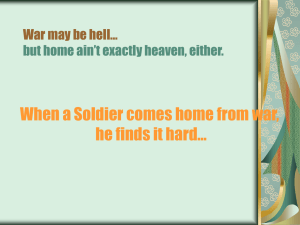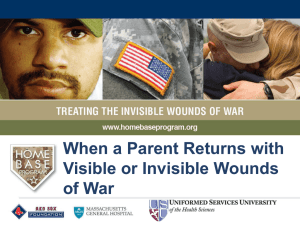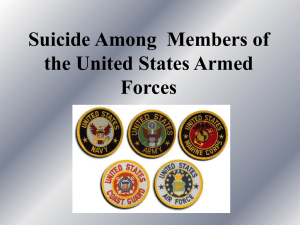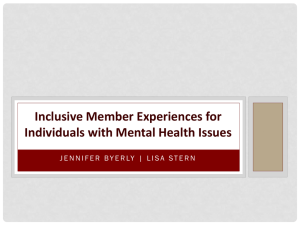Frequency of Possible Mental Disorders Among OEF/OIF
advertisement
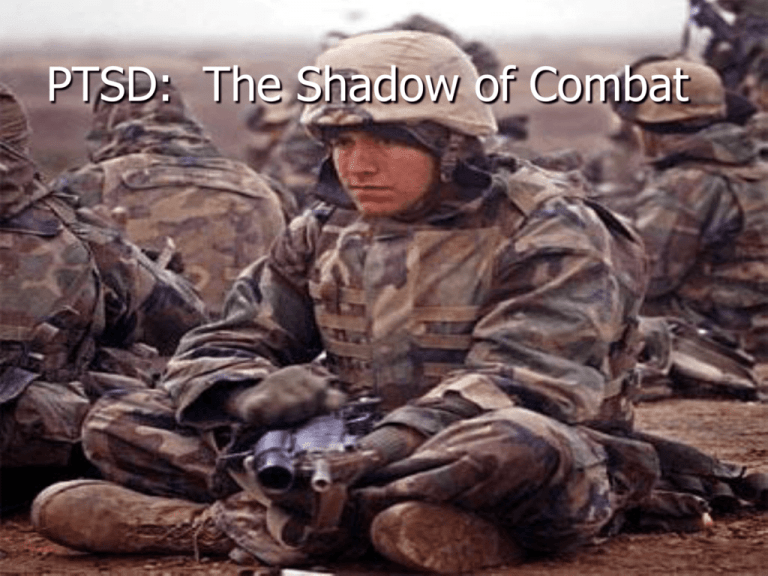
PTSD: The Shadow of Combat PTSD An Anxiety Disorder. 3-6% of adults in the United States. Twice as common in women as in men. Rates as high as 58% in heavy combat 1-14% non combat Torture/POW 50-75% Natural Disaster victims 4-16% DSM-IV diagnostic criteria for PTSD Exposure to a traumatic event in which the person Experienced, witnessed, or was confronted by death or serious injury to self or others AND Responded with intense fear, helplessness, or horror Features Appear in 3 clusters: re-experiencing, avoidance/numbing, hyperarousal Last for > 1 month Cause clinically significant distress or impairment in functioning DSM-IV diagnostic criteria for PTSD Re-experiencing Persistent re-experiencing of 1 of the following Recurrent distressing recollections of event Recurrent distressing dreams of event Acting or feeling event was recurring Psychological distress at cues resembling event Physiological reactivity to cues resembling event American Psychiatric Association. Diagnostic and Statistical Manual of Mental Disorders, 4th ed. 1994. DSM-IV diagnostic criteria for PTSD Avoidance/Numbing Avoidance of stimuli and numbing of general responsiveness indicated by 3 of following Avoid thoughts, feelings, or conversations* Avoid activities, places, or people* Inability to recall part of trauma interest in activities Estrangement from others Restricted range of affect Sense of foreshortened future *Related to the trauma American Psychiatric Association. Diagnostic and Statistical Manual of Mental Disorders, 4th ed. 1994. DSM-IV diagnostic criteria for PTSD Hyperarousal Persistent features of increased arousal 2 Difficulty sleeping Irritability or outbursts of anger Difficulty concentrating Hypervigilance Exaggerated startle response American Psychiatric Association. Diagnostic and Statistical Manual of Mental Disorders, 4th ed. 1994. History Spontaneous re-experiencing of the trauma Startle responses Irritability Depression and Guilt Phobias Multiple physical complaints Numbing Impaired concentration and memory Disturbed sleep and distressing dreams Labels Fright Neurosis Combat/War Neurosis Shell Shock Survivor Syndrome Operational Fatigue Compensation Neurosis Stats • 1.6 million troops deployed to OEF/OIF to date • Approximately 40% have accessed VA care • Three most common presenting problems: Musculoskeletal Ailments Mental Disorders (PTSD, SA/D, Depressive) “Symptoms, Signs, and Ill Defined Cond.” VA Healthcare Utilization among GWOT Veterans • 868,717 OEF/OIF who have left active duty since February 2002 437,873 Former Active Duty 430,844 Reserve and NG 40% (347,750) have accessed VA care since FY 2002 (96% outpatient) Demographic Characteristics of OEF and OIF Veterans Utilizing VA Health Care % OEF/OIF Veterans (n = 347,750) Gender Male Female Age Group <20 20-29 30-39 ≥40 Branch Air Force Army Marine Navy Unit Type Active Reserve/Guard Rank Enlisted Officer 88 % 12 7 51 23 18 12 64 13 11 52 48 92 8 Frequency of Possible Diagnoses Among OEF and OIF Veterans Diagnosis (Broad ICD-9 Categories) Infectious and Parasitic Diseases (001-139) Malignant Neoplasms (140-208) Benign Neoplasms (210-239) Diseases of Endocrine/Nutritional/ Metabolic Systems (240-279) Diseases of Blood and Blood Forming Organs (280-289) Mental Disorders (290-319) Diseases of Nervous System/ Sense Organs (320-389) Diseases of Circulatory System (390-459) Disease of Respiratory System (460-519) Disease of Digestive System (520-579) Diseases of Genitourinary System (580-629) Diseases of Skin (680-709) Diseases of Musculoskeletal System/Connective System (710-739) Symptoms, Signs and Ill Defined Conditions (780-799) Injury/Poisonings (800-999) (n = 347,750) Frequency * 40,956 3,248 13,910 75,850 7,675 147,744 121,473 56,900 71,087 110,449 37,118 55,797 165,439 138,043 73,767 % 11.8 0.9 4.0 21.8 2.2 42.5 34.9 16.4 20.4 31.8 10.7 16.0 47.6 39.7 21.2 *These are cumulative data since FY 2002, with data on hospitalizations and outpatient visits as of March 31, 2008; veterans can have multiple diagnoses with each healthcare encounter. A veteran is counted only once in any single diagnostic category but can be counted in multiple categories, so the above numbers add up to greater than 347,750. Frequency of Possible Mental Disorders Among OEF/OIF Veterans since 2002 Disease Category (ICD 290-319 code) Number of GWOT Veterans PTSD (ICD-9CM 309.81) Depressive Disorders (311) Neurotic Disorders (300) Affective Psychoses (296) Nondependent Abuse of Drugs (ICD 305) Alcohol Dependence Syndrome (303) Special Symptoms, Not Elsewhere Classified (307) Sexual Deviations and Disorders (302) Drug Dependence (304) Specific Nonpsychotic Mental Disorder due to Organic Brain Damage (310) * Total 75,719 50,732 40,157 28,734 21,201 12,780 7,685 7,076 5,764 4,654 Three Different Types of Stress Injuries Combat/Operational Stress Stress Adaptations Positive Behaviors Negative Behaviors Stress Injuries Traumatic Stress Operational Fatigue Grief Due to a Due to the Due to the terrifying or wear and tear loss of friends horrible event of deployment and leaders Traumatic Events in OEF/OIF Multi-casualty incidents (SVBIEDs, ambushes) Friendly fire Death or maiming of children and women Seeing gruesome scenes of carnage Handling dead bodies and body parts “Avoidable” casualties and losses Witnessed or committed atrocities Witnessed death/injury of a close friend or leader Killing unarmed or defenseless enemy Being helpless to defend or counterattack Injuries or near misses Killing someone up close eliefs That Can Be Damaged By Traumatic Stress Belief in one’s basic safety Belief in being the master of oneself and one’s environment Belief in “what’s right” — moral order Belief that our cause is honourable Belief that every troop is valued Belief in the basic goodness of people (especially oneself) Causes of Shame or Guilt In Traumatic Stress Injuries Surviving when others did not Failing to save or protect others Killing or injuring others Helplessness Failing to act Loss of control Even just having stress symptoms of any kind RAND Study (2008) • 1965 service members from 24 communities • 50%+ reported a friend seriously wounded or • • • • killed 45% saw dead or wounded noncombatants 10% reported injuries requiring hospitalization 18.5% met criteria for PTSD or depression 19.5% reported mTBI during deployment of which 1/3 reported concurrent PTSD or depression PTSD and Mild Traumatic Brain Injury (TBI) • Slightly more than half of combat injuries early • • in OIF came from explosions 29% evacuated from combat theater to WRAMC had evidence of TBI (Jan 2003-Feb 2007) Approximately 15% of all wounded vets have suffered TBI (4,471 cases diagnosed between October 2001 and September 2007) TBI • Physical damage by external blunt or penetrating trauma • Acceleration-Deceleration Movement (whiplash) resulting • in tearing or nerve fibers, bruising/contusion of brain Scraping of brain across bony base of skull leading to olfactory, oculomotor, acoustic nerve damage. – Loss of sense of smell and reduction of taste (anosmia), double and/or blurred vision, dizziness or vertigo – Usually remit after several days or weeks (nerves recover or regenerate) Levels of TBI • Mild – LOC for less then 30 minutes w/normal CT and/or MRI – Altered mental state: “dazed,” “confused,” “seeing stars” – PTA less then 24 hours (unable to store or retrieve new information) – Glasgow Coma Scale (GCS): 13-15 Levels of TBI • Moderate – LOC less than six hours w/abnormal CT and/or MRI – PTA less than seven days – GCS: 9-12 • Severe – LOC greater than six hours w/abnormal CT and/or MRI – PTA greater than seven days – GCS: 1-8 Post-Concussion Syndrome (PCS) • Symptoms immediately post-injury may include: – – – – Memory, attention, concentration deficits Fatigues, poor sleep, dizziness, headaches Irritability, depression Anxiety • Most common: free-floating anxiety, fearfulness, intense worry, generalized uneasiness, social withdrawal, heightened sensitivity, related dreams • Recovery (mild TBI) expected within 4-12 weeks; however, some symptoms may linger for months to years Assessment • Post concussion Syndrome (PCS) – – – – – – – – – – Insomnia Memory Deficits Poor Concentration Depressed Mood Anxiety Irritability Headache Dizziness Fatigue Noise/Light Intolerance • PTSD – – – – – – – – – – Insomnia Memory Deficits Poor Concentration Depressed Mood Anxiety Irritability Intrusive symptoms Emotional Numbing Hyperarousal Avoidance behavior Mild TBI among OIF Returnees (Hoge et al., 2008) • 2,525 soldiers included in study (assessed 3-4 months post-deployment) – 5% (124) reported injury with LOC (up to several minutes) – 10% (260) reported injury with altered mental status w/out LOC – Four soldiers reported LOC longer than 30 minutes – 17% (435) reported other injuries TBI Among OIF Returnees (Hoge et al., 2008) Of those who reported LOC, 44% met criteria for PTSD, as compared to: -27% of those with altered mental state -16% of those with other injuries -9% of those with no injuries Blast Injuries • Over 50% of combat injuries result from bombs, • • grenades, land mines, missles, mortar/artillery shells Account for majority of brain injury in theater with GSWs, falls, and MVAs close behind TBI among service members as high as 22% – 2003-2008: over 6,600 TBI – Four major polytrauma centers (MN, CA, FL, VA): 923 OEF/OIF patients with TBI Blast Injury • Blast injuries results from pressure generated from an explosion which causes in overpressurization • Air-filled organs (ears, lung, GI tract) and organs surrounded by fluid filled cavities (brain, spinal cord) susceptible Hoge et al. (2006) • 01 May 2003 – 30 April 2004: – OEF (Afghanistan) – OIF (Iraq, Kuwait, Qatar) – Other (Bosnia, Kosovo, etc.) • N = 303,905 Marines and Soldiers – OEF: 11.3% of 16,318 – OIF: 19.1% of 222,620 – Other: 8.5% of 64,967 Hoge at al. (2006) • Combat Experiences: OEF Any 46.0% Witnessed 38.1% Discharged 6.2% Felt in Danger 24.6% OIF OTHER 65.1% 7.4% 49.5% 5.3% 17.8% 0.4% 50.3% 3.2% Suicidality and PTSD PTSD patients are 6 times more likely to attempt suicide than the general population PTSD has greater risk of increased number of suicide attempts than all other anxiety disorders Kessler R et al. Arch Gen Psychiatry 1999;56:617-626. Therapeutic Intervention Teach patients that PTSD Represent psychobiologic reaction to overwhelming stress Not character flaw or sign of weakness Fear that will be seen as “damaged” or emotionally unstable May lose right to carry weapon May be viewed as unstable Traumatized patients Notoriously reluctant to seek help Particularly from mental health professionals Therapeutic Intervention PTSD symptom relief Usually requires specialized techniques help patient confront fears and emotional responses to trauma in more structured format Without becoming overwhelmed Treatment involves Reducing level of distress associated with memories of event Quelling resultant physiological reactions Focus on behavioral outcomes rather than biomedical indices Therapeutic Intervention Effective Exposure Therapy Cognitive-Behavioral Therapy Helping confront painful thoughts and feelings Helping process thoughts and feelings Interpersonal therapies Understanding ways in which traumatic event continues to affect relationships and other aspects of their lives Group Therapy May also help reduce isolation and stigma Pharmacotherapy In PTSD, randomized trials have shown effectiveness of SSRIs TCAs MAOIs SSRIs 1st-line treatment safer and better tolerated Only FDA-approved drugs Sertraline (Zoloft) Paroxetine (Paxil) Pharmacotherapy -blockers May reduce peripheral sympathetic tone Perhaps, potential to worsen depression Beneficial effects of drug therapy May not be evident for 8 weeks or more Once drug a drug seems effective Continue for at least 12 months Summary Most people will gradually recover from psychological effects of traumatic event PTSD will develop in a substantial portion of subjects exposed to trauma PTSD Failure to recover from nearly universal set of emotions and reactions Typically manifested by Distressing memories or nightmares related to trauma Attempts to avoid reminders of trauma Heightened state of physiological arousal Summary Biologic mechanisms of PTSD Changes in brain regions Amygdala and hippocampus Associated with fear and memory Changes in systems involved in coordinating body’s response to stress Hormonal Neurochemical Physiological Summary Treatment Educate patient about nature of disorder Provide safe and supportive environment Discuss trauma and impact Relieve distress associated with Memories reminders of events Treatment strategies with variable success Exposure therapy Pharmacotherapy cognitive therapy Summary Pharmacotherapy SSRIs Effective and well tolerated Many with PTSD do not respond to drugs Need to better study this subset Pilot studies with propranolol Need confirmation References • Arenofsky, J. (2008). Traumatic brain injury: An exploding problem. VFW • • • • • • Magazine, 95(5), 14-20. Arnkoff, D.B., Class, C.R., & Shapiro, S.J. (2002). Expectations and preferences. In J.C. Norcross (Ed.), Psychotherapy relationships that work: Therapist contributions and responsiveness to patients (pp.335-356). Oxford: Oxford University Press. Foa, E.B., Keane, T.M., & Friedman, M.J. (eds.). (2000). Effective treatments for PTSD: Practice guidelines from the International Society for Traumatic Stress Studies. The Guilford Press: New York. Follette, V.M., Ruzek, J.I., & Abueg, F.R. (eds.). (1998). Cognitivebehavioral therapies for trauma. The Guilford Press: New York, pp. 162190. Friedman, M.J. (2006). Posttraumatic stress disorder among military returnees from Afghanistan and Iraq. American Journal of Psychiatry, 163(4), 586-593. Friedman, M.J. (2000). Posttraumatic stress disorder: The latest assessment and treatment strategies. Compact Clinicals: Kansas City, MO. Iraqi War Clinician Guide (2nd edition). National Center for Post-Traumatic Stress Disorder References • Kushner, M.G., & Sher, K.J. (1991). The relation of treatment fearfulness • • • • and psychological service utilization: An overview. Professional Psychology: Research and Practice, 22, 196-203. Hoge, C.W., McGurk, D., Thomas, J.L., Cox, A.L., Engel, C.C., & Castro, C.C. (2008). Mild traumatic brain injury in U.S. soldiers returning from Iraq. The New England Journal of Medicine, 358(5), 453-463. Hoge, C.W., Auchterloine, J.L., & Milliken, C.S. (2006). Mental health problems, use of mental health service, and attrition from military service after returning from deployment to Iraq or Afghanistan. Journal of the American Medical Association, 295(9), 1023-1032. Hoge, C.W., Castro, C.A., Messner, S.C., McGurk, D., Cotting, D.I., & Koffman, R.L. (2004). Combat duty in Iraq and Afghanistan, mental health problems, and barriers to care. The New England Journal of Medicine, 351(1), 13-22. Kennedy, J.E., Jaffee, M.S., Leskin, G.A., Stokes, J.W., Leal, F.O., & Fitzpatrick, P.J. (2007). Posttraumatic stress disorder and posttraumatic stress disorder-like symptoms and mild traumatic brain injury. Journal of Rehabilitation Research and Development, 44(7), 895-920. References • McFall, M., Malte, C., Fontana, A., & Rosenheck, R.A. (2000). Effects of an • • • • outreach intervention on use of mental health services by veterans with posttraumatic stress disorder. Psychiatric Services, 51, 369-374. Murphy, R. (2006). Clinical methods for fostering combat veterans’ engagement in mental health treatment. Two day workshop held at Salisbury, North Carolina VA Medical Center Newman, C.F. (1994). Understanding client resistance: Methods for enhancing motivation to change. Cognitive and Behavioral Practice, 1, 4769. Prochaska, J.O. and DiClemente, C.C. (1992). In search of how people change: Applications to addictive behaviors. American Psychologist, 47, 1102-1114. Taylor, S. (2003). Outcome predictors for three PTSD treatments: Exposure therapy, EMDR, and relaxation training. Journal of Cognitive Psychotherapy, 17(2), 149-162. References • Taylor, S. (ed.). (2004). Advances in the treatment of posttraumatic stress • disorder: Cognitive-behavioral perspectives. Springer Publishing Company: New York Zweben, A., & Li, S. (1981). The efficacy of role induction in preventing early dropout from outpatient treatment of drug dependence. American Journal of Drug and Alcohol Abuse, 8(2), 71-83.

